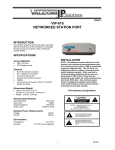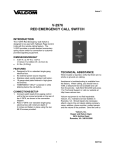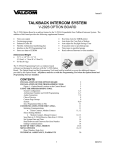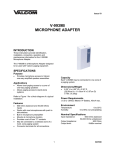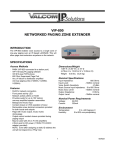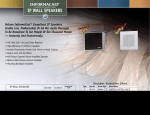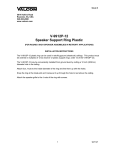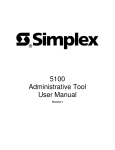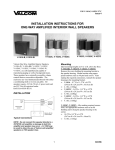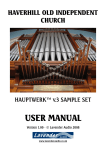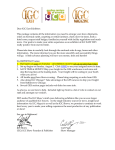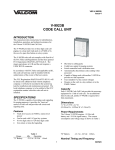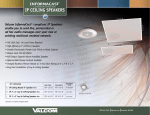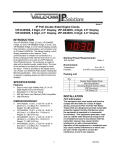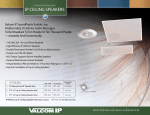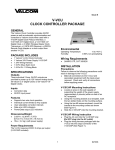Download Valcom V-9908 User's Manual
Transcript
Issue 6 V-9908 MESSAGE/PAGE PANEL Introduction These instructions contain the specifications and guidelines necessary to install, operate, and maintain the V-9908, Message/Page Panel. The V-9908 Message/Page Panel provides a handheld push-to-talk microphone for live pages and storage for eight messages. The V-9908 is compatible with all Valcom self-amplified speakers. The microphone, power and internal memory are monitored, with visual and audible indicators if any fault conditions are detected. When used with Valcom Supervised Distributed Amplified One-Way Paging Speakers and Horns, full system supervision including the speaker audio path is possible. Microphone Input Input Impedance: >5000 Ohms Input sensitivity: 1kHz 1 millivolt for -12dBm output (output terminated with 100 Ohms) Audio Frequency Response: Mic – Output: 150Hz – 7,000Hz Frequency Response: Stored Messages – Output: 150Hz – 3,500Hz Input Sensitivity (mic): 1kHz 1 millivolt for -12dBm output (output terminated with 100 Ohms) Signal to Noise (Idle mode, Ref -12dBm): >70dB Signal to Noise (Mic active, Ref -12dBm) >50dB Distortion (Mic – Output): < 1% THD at -12dBm Output Impedance: < 25 Ohms Nominal output level: -12dBm (Ref 600 Ohms) Maximum output level: 0dBm (before clipping) Applications Valcom Supervised Distributed Amplified One-Way Paging Systems. Refer to Figure 1 for a block diagram of a typical installation. Features Dynamic noise canceling handheld microphone for live page Provides up to 8 minutes of high quality digital recording Stores and plays up to 8 messages Eight (8) preprogrammed messages included PC Programmable Message panel fully supervised Provides speaker line supervision Provides microphone supervision Provides DC power supervision Allows remote message activation Visual and audible system trouble indication Audible signal cancel button Power "ON" indicator Mounts in most 4 gang deep electrical box System Supervision Main Audio Channel: 30Hz tone (inaudible) Microphone: 1kHz tone supervises the preamp, cable and element Microphone Switch: DC loop with 4.7K Ohm resistor Audio Output: DC loop terminated with a 4.7K Ohm 1/4W resistor Voice Storage Memory: Fixed segment memory monitoring Main Power: 9VDC battery provides redundant supervision power Battery: Low voltage monitoring All system faults are indicated by both an audible and visual alarm. The audible alarm may be silenced, however, the visual indicator will continue to illuminate until the fault is removed. Dimensions 5"W x 4.25"H x 2”D (12.7cm W x 10.8cm D x 5.08cm H) 4 lbs. (1.5Kg) User Controls (Figure 1) Specifications Push-to-Talk Microphone Pushbuttons to activate pre-recorded messages Pushbutton to cancel message play Pushbutton to cancel wire fault alarm Power Requirements Operating Voltage 22 – 26VDC Current 250mA 1 947980 The final format is standard 8 bit uLaw at 8kHz compressed format. Indicators (Figure 1) Power “ON” Individual message play Visual system fault Audible system fault with silence button Although it is possible to upload and download during system operation, it is recommended to perform this function when the system is not in use. This insures that messages will not be corrupted during a download or upload. After message write remove battery and DC power momentarily. Total voice message storage is 8 minutes and there are no other restrictions on lengths of individual messages. It is possible to record tones, signals, etc. that will operate in the voice band range. For additional programming information refer to the Message Control Panel Program Tool Help Menu. Inputs (Figure 2) Eight remote message activation inputs via single pole pushbutton switches. RS-232 provided for message uploads and downloads. Handheld microphone for “live” announcements Outputs (Figure 2) Audio output Page/Message active contact External contact closure activates on system fault. System Fault Monitoring The main audio channel has an inaudible tone present whenever a page or message is not active. This tone will verify the integrity of the audio channel from the microphone to the audio output. A Valcom V-1096 Audio Interface (included) is required when the speaker runs are non-supervised. System Operation The Push-to-Talk microphone is used for live pages. The microphone has priority over message playback paging. Pressing the Push-to-Talk switch on the microphone will activate the audio output and override (and CANCEL) any message playback in process. Proper operation of the voice memory flash device is monitored by continuous reading a fixed segment of the memory. This insures the flash memory integrity as well as the circuitry that attaches it to the DSP controller. It will detect defective components and interconnection faults as well as actual memory failure. A group of eight (8) front panel buttons with associated LED’s are used to activate stored messages. When a message is activated, the LED will indicate the status. If the message is playing, the LED will illuminate. Messages are not chainable. A message must be finished before an additional message may be activated. If a message button is pressed while a message is playing the original message will cancel. In the event of a system or power failure, the “System Fault LED” will illuminate and an audible alarm will sound. The Audible alarm may be silenced by pressing the “Cancel Audible” button, however the “System Fault” LED will remain lit until the fault has been corrected. A 9 Volt battery located on the back of the Page Panel provides the necessary power to operate the fault circuits in the event of a power failure. The 9 Volt battery is monitored and a system fault will occur when the battery voltage drops. A contact closure is available to signal a remote monitoring panel when a system fault occurs. A “MESSAGE CANCEL” button is available to cancel any message playing. Using the program tool, all messages can be programmed for the following play scenarios: 1 play per button activation 2 plays per button activation 3 plays per button activation Continuous plays per activation (cancelled via “MESSAGE CANCEL” button) Full System Supervision using Valcom One-Way Supervised Self-Amplified Speakers and Horns with the Page Panel includes monitoring of the audio and power pairs to the speakers for shorts, opens and grounds. A fault detected on these lines will cause the “System Fault” LED to illuminate. A Valcom V-9999 End of Line device (not included) is required for speaker line termination. Programming Voice Messages Eight (8) preprogrammed messages are provided in the V-9908. (See Table 1, for script of preprogrammed messages). Installation A serial port (RS-232) is provided to upload and download voice messages. The program tool provides all editing and message processing (AGC, response shaping, wave file conversions, etc.). Refer to the figure on the following pages for wiring connections. All connections should be made to the Message Panel and double-checked prior to connecting DC power. 2 947980 Figure 1 shows microphone, message activate and fault indication control locations. System Troubleshooting There are 4 LED’s located on the PC board for system troubleshooting. They are: LED D9 - Mic. Switch Fault (ON = fault detected) LED D10 - DC Fault (low battery or internal monitoring System fault) (ON = fault detected) LED D11 - Audio loop back fault (ON = Fault in Mic. audio or 30Hz amplifier loop back) LED D12 - Flash Memory Error (ON = Checksum failed) Figure 2 shows remote message activate terminal connections, output connections, programming and power connections located on the back of the message panel. Figure 3 shows a typical connecting arrangement and other feature connections for a Fully Supervised system, including speaker wire run supervision. Fully supervised systems require a Valcom V-9999 End of Line terminator (not included). Refer to Figure 3 to connect the message active contact and remote activation of the messages. Using a RJ-45 connector, connect speaker audio (Tip and Ring) and speaker power to board mounted connector as shown on connecting diagram. (A remote mounted connecting block will be required to access these connections.) Referring to Figure 3, connect 24VDC as indicated. TECHNICAL ASSISTANCE When trouble is reported, verify the unit is turned on and there are no broken connections leading to the unit. Assistance in troubleshooting is available from the factory. When calling, you should have a VOM and a test set and call from the job site. Call (540) 563-2000 and press 1 for Technical Support, or visit our website at http://www.valcom.com. When installed without full wire run supervision, a Valcom V-1096 Audio Interface is required to be installed inline on the audio output between the V-9908 Message Panel and the first connected device (page control or speaker – refer to page 5 for details) Valcom equipment is not field repairable. Valcom maintains service facilities in Roanoke, VA. Should repairs be necessary, attach a tag to the unit clearly stating company name, address, phone number, contact person, and the nature of the problem. Send the unit to: Valcom, Inc. Repair and Return Dept. 5614 Hollins Road Roanoke, VA 24019-5056 Programming the Message Panel Refer to the programming guide included with the message panel documentation. VALCOM LIMITED WARRANTY Valcom, Inc. warrants its products only to the original purchaser, for its own use, to be free from defects in materials and workmanship under conditions of normal use and service for a period of one year from the date of shipment. This Limited Warranty obligation shall be limited to the replacement, repair or refund of any such defective device within the warranty period, provided that: 1. inspection by Valcom, Inc. indicates the validity of the claim; 2. the defect is not the result of damage, misuse or negligence after the original shipment; 3. the product has not been altered in any way or repaired by others and that factory sealed units are unopened (a service charge plus parts and labor will be applied to units defaced or physically damaged); 4. freight charges for the return of products to Valcom are prepaid; 5. all units 'out of warranty' are subject to a service charge. The service charge will cover minor repairs (major repairs will be subject to additional charges for parts and labor). This Limited Warranty is in lieu of and excludes all other warranties, expressed or implied and in no event shall Valcom, Inc. be liable for any anticipated profits, consequential damages, loss of time or other losses incurred by the buyer in connection with the purchase, operation, maintenance, installation, removal or use of the product. The maximum liability of Valcom under this warranty is limited to the purchase price of the specific Product covered by the warranty. Disclaimer. Except for the Limited Warranty provided herein, the product is provided “as-is” without any warranty of any kind whatsoever including, without limitation, any WARRANTY OF MERCHANTABILITY, FITNESS FOR A PARTICULAR PURPOSE OR NON-INFRINGEMENT. This warranty specifically excludes damage incurred in shipment. In the event a product is received in damaged condition, the carrier should be notified immediately. Claims for such damage should be filed with the carrier involved in accordance with the F.O.B. point. Headquarters: Valcom, Inc. 5614 Hollins Road Roanoke, VA 24019-5056 Phone: (540) 563-2000 FAX: (540) 362-9800 3 947980 Noise Canceling Handheld Push to Talk Microphone Message Cancel Button Eight (8) Message Play Buttons Eight (8) Message Play Indicators Message Label Window Fault Audible Cancel Button Figure 1: User Control Locations System Fault Indicator Message Activate Contact Closure Inputs Serial Programming Input 9 V Alkaline Battery Output Connections RJ-45 Connection Detail Audio Output Pair CONTACT CLOSURE PAIR PIN 1 Message Play Contact Pair -24VDC Output 2APair 24VDC Input Power Connection PIN 8 Figure 2: Rear Connections RJ45 Pin Assignment Pin 1 Audio Out Pin 2 Audio Out Pin 3 Supervision 4.7K resistor (A “no fault” condition results in 4.7K ohm between pins 3 and 6) Pin 4 Message Play Contact (Pins 4 and 5 short when audio is present on pins 1 and 2) Pin 5 Message Play Contact Pin 6 Supervision 4.7K resistor Pin 7 24VDC Pin 8 24VDC Common Figure 2: Rear Connections 4 947980 Remote Activation Single Pole Switch Valcom Amplified Supervised Speakers Message 1 Message 2 Message 3 Message 4 Message 5 Message 6 Message 7 Laptop computer Message 8 Ground RS 232 Program Port Cancel Message Remote Message Play Inputs Connect field wiring directly to speaker terminals or speaker pigtails. Tip Ring Gnd -24vdc Tip Ring Gnd -24vdc COM - 24VDC 9 Volt Alkaline Battery V-9999 EOL Terminator not included Figure 3: Typical Connections - Fully Supervised System Shorting Jumper Position 1 2 3 AUDIO OUTPUT CONTACT CLOSURE AUDIO INPUT V-1096 AUDIO ADAPTER Shorting Jumper Position 1 2 3 1 Shorting Jumper Position 2 3 Default shorting jumper positions are shown. (from top to bottom – up, up, down). The only time that these need to be moved is when connecting the output of the V-1096 to a lo-z microphone input. In this case, all of the jumpers must be moved. (From top to bottom down, down, up) When the V-9908 is not being used as shown in Figure 3, a V-1096 Audio Adapter must be utilized. 1) Connect the audio output of the V-9908 to the audio input of the V-1096. 2) Connect the audio output of the V-1096 to the audio input of the receiving system. Examples of receiving systems include a tip/ring telephone input on a Valcom Page Control, the tip/ring audio input of one or more Valcom Self Amplified Speakers, a line level music or auxiliary input on a Valcom page control, IP Audio gateway or amplifier, or a lo-z microphone input. In the case of a lo-z microphone input, such as that found on Valcom MultiPath or Class Connection systems, all of the shorting jumpers must be moved from the default positions shown above. 3) If the audio input of the receiving system requires a “loop start” connection, then connect the message play contacts of the V-9908 to the Contact Closure input of the V-1096. 4) If the audio input of the receiving system requires an activation closure, then connect the message play contacts of the V-9908 to the activation input of the receiving system. 5 947980 Preprogrammed Messages included in the V-9908 *In order to personalize these messages, please refer to content found on the CD included with the V-9908. Message 1: (Triple buzz, repeated three times) “May I have your attention, please. A fire emergency has been reported in the building. While this is being verified, please leave the building by the nearest exit or exit stairway. Do not use the elevators”. Message 2: (Triple buzz, repeated three times) “May I have your attention, please. An emergency has been reported in the building. While this is being verified, please leave the building and report to the designated assembly area for your group”. Message 3: May I have your attention, please. “The National Weather Service has issued a Severe Weather Warning for our area”. Message 4: (Triple buzz, repeated three times) “May I have your attention, please. A fire emergency has been reported in the building. While this is being verified, please leave the building by the nearest exit”. Message 5: (Whoop tone twice) “May I have your attention, please. An emergency has been reported in the building. While this is being verified, please, stand by for further instructions”. Message 6: (Chime three times) “May I have your attention, please. The building emergency has ended; an all clear has been given. Please resume normal activities”. Message 7: “This is a test of the building public announcement system. This system is designed to provide up to the minute communications to the workforce during emergencies. In an Emergency a professional security force will provide real time verbal exit instructions to specific zones within the complex, or to the entire complex from the central alarm station in the security office. This is a test”. Message 8: (Train Whistle) Table 1 6 947980






